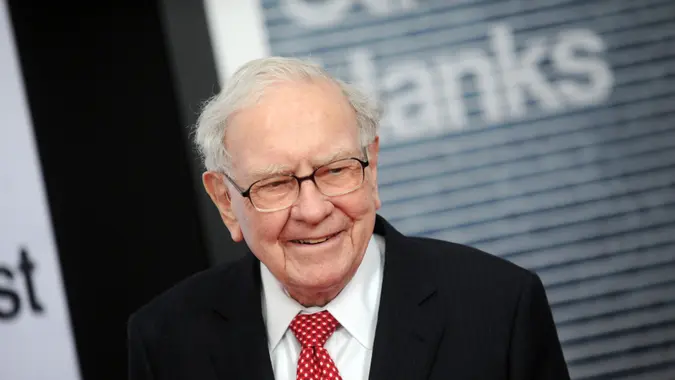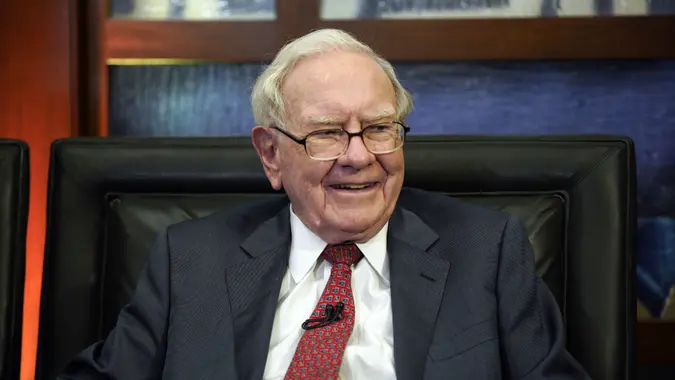Why Is Investing Important?

Commitment to Our Readers
GOBankingRates' editorial team is committed to bringing you unbiased reviews and information. We use data-driven methodologies to evaluate financial products and services - our reviews and ratings are not influenced by advertisers. You can read more about our editorial guidelines and our products and services review methodology.

20 Years
Helping You Live Richer

Reviewed
by Experts

Trusted by
Millions of Readers
If you are not yet investing, you may be wondering why you should. For most people, the most important reason to invest is so you will have enough money to live on after you retire. A comfortable retirement isn’t the only reason to invest, of course. You may also want to build your wealth to pass it on to your children or donate to charitable causes.
Learn: 5 Things You Must Do When Your Savings Reach $50,000
A common misconception is that it’s too risky or you need a large amount of money before you can invest — but this isn’t true. People often confuse saving and investing. Saving is setting aside money for short-term goals like building an emergency fund, while investing can help you achieve longer-term goals, like retirement.
Here’s what you need to know about why investing is important.
Why Do People Invest? Key Benefits of Investing
People invest for a variety of reasons. It can help you build wealth, beat inflation, prepare for retirement and generate passive income. Here’s why investing is important and its key benefits.
Building Wealth Over Time
When you invest, you earn money on your money. When you leave these earnings in your investment account, you’re earning money on your earnings, too. When your investment is returning 10% — like the S&P 500 — instead of 2% — like a CD or savings account — the importance of compound interest becomes clear.
Here’s an example. Joe is 26 years old and puts $5,000 per year in his IRA. He invests his $5,000 per year in an S&P index fund that returns an average of 10% per year. He does this for 40 years, until he retires at age 66.
In the 40 years he worked, Joe has saved $200,000 toward his retirement — $5,000 per year for 40 years. Because he invested this money, and his investment earned the average return of the S&P 500, he now has $2,434,259 in his retirement account.
If Joe had put his money in a savings account that earned 2% interest, he would have $441,177.17.
Beating Inflation
The annual average return of the S&P 500 adjusted for inflation is 6.89%. The average inflation rate from 1914 to today is 3.30% per year, so any investment that returns less than 3.30% per year is causing the investor to lose purchasing power over time.
Inflation causes prices to go up, which means you can buy less with the same amount of money. Inflation affects everything we buy — food, housing, energy, etc.
If the amount you are earning on your money is lower than inflation, you’re losing purchasing power. Here’s an example. Suppose you have $1,000 invested at the bank, earning 1% interest. Inflation is 2%. Each year, the money you are saving will buy 1% less — 2% inflation minus 1% interest on your savings. One percent may not seem like a big deal, but add it up over 40 years and you’ve got a problem.
Creating Passive Income
It’s possible to earn passive income by investing in dividend stock, rental properties and other income-generating investments. Passive income is money you earn without much effort and can help you become more financially independent. Although, it doesn’t mean there’s no effort involved at all.
For example, you can earn rental income by investing in rental properties. The IRS considers this passive income because you receive steady cash flow from tenants without having to work at the property regularly. However, it still involves upfront work, active management and tenant challenges that could disrupt your cash flow.
Preparing for Retirement
No matter how rewarding your life’s work is, at some point, you may decide to stop doing it. When you do, you’ll need to support yourself after the paychecks have stopped. Social security and pensions may be one way, but they’re only part of the picture. Investing during your working years can help you live worry-free in retirement.
There are various retirement plans where you can invest your money, including IRAs (Roth and traditional), SEP IRA, SIMPLE IRA, 401(k) (Roth and traditional), solo 401(k) and more. Note that there are limits on the amount of money you can save in an IRA, 401(k) or another retirement account. If you want to save more, you can put it in a regular investment account, but you won’t get the tax deferral.
Types of Investments and Their Importance
There are many types of investments, including real estate, stocks and bonds and alternative investments like gold and cryptocurrency. It’s typically recommended to diversify your investments, which is the practice of spreading out investments across different asset classes to reduce risk.
Stock Market Investments
Investments in the stock market involve buying shares of publicly traded companies. This allows investors to own a portion of the business. There are different types of stock market investments, including common and preferred stocks, defensive stocks, large-cap, mid-cap and small-cap stocks, growth stocks, value stocks and more.
Historically, the stock market has outperformed other investment options over the long term and outpaces inflation over time. You can also diversify by investing in various stocks to help spread risk and stabilize returns.
Bonds and Fixed-Income Investments
A bond is a debt security that allows investors to lend money to a corporation or government at a certain interest rate for an amount of time. Bonds and other fixed-income investments provide a steady stream of income and they’re considered a more predictable and lower-risk investment option compared to stocks.
Bonds have no ownership rights, so investors don’t benefit from the company’s growth. However, you won’t be as impacted when the company isn’t doing well as long as it remains current on its loans.
Real Estate Investments
Real estate investing involves purchasing, owning, managing, renting or selling properties for a profit. Unlike stocks and bonds, it’s a physical asset that can appreciate in value while potentially generating rental income. Real estate investments have historically provided strong returns for investors, although not as well as stocks.
In addition to real estate’s passive income and appreciation potential, there are tax advantages. Depreciation and mortgage interest deductions can help lower your tax bill. Investors can also potentially defer capital gains taxes through a 1031 exchange. This is a transaction where you swap one investment property for another, although the exchange structure can be difficult due to its rules, strict timelines and required planning to ensure compliance with IRS regulations.
Alternative Investments
Alternative investments include asset classes outside of traditional stocks, bonds and real estate. There are several different kinds of alternative investment types, such as precious metals, cryptocurrency, collectibles, commodities and more.
Precious metals like gold and silver and some collectibles are tangible assets that maintain value in economic downturns. Crypto — like Bitcoin and Ethereum — have high growth potential, but they’re also highly volatile and have no intrinsic value.
Final Take
What’s the most important thing to remember about investing? It’s not to “buy low and sell high” or to “buy what you know” — although those are both important. It’s simply to start. Take $100, $1,000 or whatever you can and invest it. You may see the value of your investment go up and down week to week, month to month or even year to year, but historically, over time, the general trajectory of the market is always up. So start today.
https://www.usgoldbureau.com/news/post/how-recession-fears-are-shaping-precious-metals-demand
Karen Doyle contributed to the reporting of this article.
FAQ
- Why should I invest instead of just saving money?
- Investing has the potential for higher returns compared to regular savings accounts. Although investing is riskier than saving, it gives investors the opportunity to build wealth and reach long-term financial goals like retirement.
- Why does investment help with retirement?
- Investing helps with retirement because it allows your money to grow over time. By putting your money in a retirement account, you benefit from compounding growth and tax benefits, helping you build a secure financial future for retirement.
- Is investing risky?
- Yes, investing can be risky. There's a possibility that you could lose money due to market fluctuations. On the other hand, higher risk can potentially lead to greater earnings.
- How can a beginner start investing with little money?
- A beginner can start investing with little money by picking a strategy based on the amount they want to invest, their investment goals and the amount of risk they are willing to take. Even a small amount of money can help you steadily grow your wealth.
- What's the best investment strategy for long-term success?
- The best investment strategy for long-term success is to start early, diversify, understand your risk tolerance and balance your needs over time. For personalized guidance, consider speaking with a financial expert who can help tailor a strategy to your goals.
Our in-house research team and on-site financial experts work together to create content that’s accurate, impartial, and up to date. We fact-check every single statistic, quote and fact using trusted primary resources to make sure the information we provide is correct. You can learn more about GOBankingRates’ processes and standards in our editorial policy.
- Official Data Foundation. "Stock market returns since 1926."
- Official Data Foundation. "Value of $1 from 1926 to 2022."
- Social Security Administration. "Alternate Measures of Replacement Rates for Social Security Benefits and Retirement Income."
- Trading Economics. "United State Inflation Rate."
 Written by
Written by  Edited by
Edited by 

























